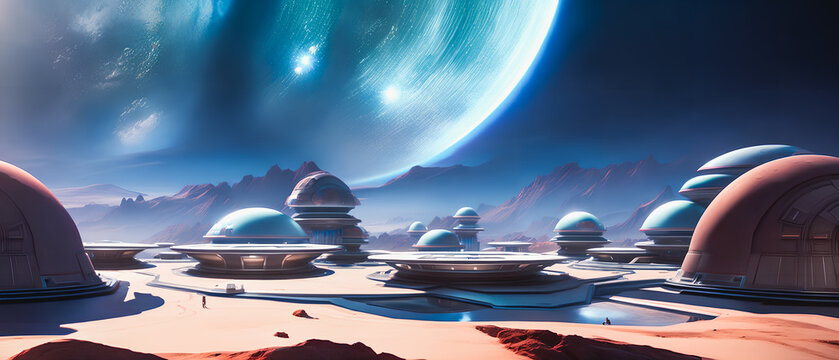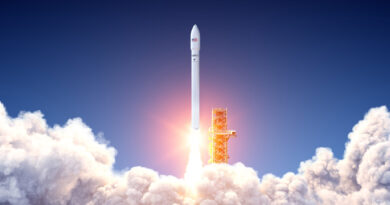Colonizing Space: Science Fiction?
Assume we are living in the far future where rocket costs have dropped to $100 per kilogram and there is an ongoing Cold War. Advanced astrophysics has traditionally been correlated with military strength because rocket technology can also be used for missiles. As a result, major countries would strive to demonstrate their strength in space exploration by means such as setting up space colonies. While a space colony might have little monetary value, it would demonstrate the founding country’s rocket launching prowess due to the need for constant resupply missions. In addition, crucial technologies may be developed as a result of the mission, similarly to how satellites were created thanks to the Cold War between the United States and the Soviet Union.
The First Location
There are a few candidate locations for space colonies: the Moon, Mars, asteroids, and even artificial orbital habitats. However, the Moon would appear to be the logical first step in space colonization, primarily because of its location: the Moon is much closer to Earth than is any other planet. Orbital habitats may be closer, but they would require immense mineral resources to build, which would be difficult to obtain solely from Earth. The close distance of the Moon would mean a relatively lower set-up price compared to other candidates. However, a colony on the Moon would have little scientific and economic value. Therefore, the Moon base must be used as a preparation for future colonization efforts in more valuable locations. For instance, the low gravity of the Moon can allow for a lower launch cost than on Earth once the colony is well established. As a result, future colonies can be established and supplied at a low cost by using launch pads on the Moon. In addition, a Moon base can be a good practice, boosting the development of necessary technology and protocols.
Precedents on Earth
Perhaps a suitable comparison to space colonies are research bases in the South Pole during the winter, when the cold climate and hostile weather isolates the base from the rest of the world. A space base would be similarly difficult to reach and would have extremely inhospitable environments. Therefore, South Pole bases in the winter can be used as examples of the possible problems that might arise in a space colony. There, the majority of the employees are scientists, with the exception of one doctor. When there is an urgent patient, planes have to bring the patient to more hospitable regions where medical care is available, but such ventures are highly risky and are thus rarely conducted. Similarly, winter resupplies are rare and difficult. Communication is mainly done through satellites, though there are times where even this is not available. Food is rarely raised in the base and has to be brought in.
Space colonies can mimic the protocols of South Pole bases. For instance, personnel should be screened for physical and mental health prior to departure. In the South Pole, the isolation often damages the employees’ mental health, and advanced medical care is difficult; the same would apply to a Moon base. However, South Pole bases and space colonies are fundamentally different in that South Pole bases rarely grow larger than ten people during the winter. On the other hand, a Moon colony would need to house hundreds, if not thousands, to make it valuable. As a result, the colony should not rely solely on supply missions from Earth for food, and more infrastructure should be established in the colony. For instance, a decent hospital would be needed to deal with multiple patients at once, and there would have to be a variety of jobs, not just scientists and doctors.
Necessary Resources
The most important resource needed for a Moon base would be water. When starting the colony, a certain amount of water should be brought along. However, this amount will be limited because water is very dense. As a result, people should live inside pressurized domes and urine and other waste products should be recycled for water. The domes would also help maintain the oxygen level. Afterwards, machinery can be brought to extract water from lunar soil. Excess water can be converted to oxygen for breathing and hydrogen for rocket fuel, aiding the expansion of the colony.
The carbon dioxide exhaled by the people can be converted back to oxygen partially through the cultivation of plants, which can also aid in feeding the colonists. While food would mostly be brought from the Earth in the beginning, more and more should be grown on the Moon as the colony grows in size. Plants are more suitable because animals would require a lot of water, which would be difficult to provide on the Moon.
There are two methods by which plants can be grown on the Moon: using aeroponics and planting in lunar soil. However, it would be more beneficial to use aeroponics, which means that plants are grown in the air with water being sprayed directly to the roots via a colloid. While plants could be grown directly in lunar soil, it would be significantly slower than on Earth, and it would waste precious water. Other necessary nutrients that cannot be obtained through eating plants such as iron can be consumed in the form of tablets, which can be brought from Earth. Tablets would be more weight-efficient than traditional food, while also being absorbed more readily into the body.
As for the shelter, modular tent-like rooms can be brought to the Moon. This method can reduce the weight and thus the shipping cost, while also making expansion easier. In addition to the shelter, machinery should be brought from Earth. The shipping costs would likely be expensive, but setting up a manufacturing plant on the Moon would be much more expensive.
What would this mean for the future?
In a world with a well-established moon base, there would be a much better chance at colonizing other planets or asteroids. These colonies could provide Earth with much needed resources such as titanium and could shelter thousands of humans. Still, this concept is about the far future. Current launch costs are too high to justify a space colony, especially one that does not bring immediate value. However, it is possible that humanity will be capable of such huge feet in the far future.



